Fire Impacts and Dynamics of Seasonally Dry Tropical Forest of East Java, Indonesia
Abstract
:1. Introduction
2. Materials and Methods
2.1. Study Area
2.2. Field Data Collection
2.3. Data Analyses
3. Results
3.1. Structure and Composition of SDTF
3.2. Comparison of SDTF Fire-Age Classes
3.3. Evidence for SDTF–Savanna Transitions
4. Discussion
4.1. Characteristics of SDTF at Baluran
4.2. Effect of Fire on SDTF
4.3. Evaluating Evidence for Transitions
5. Conclusions
Author Contributions
Funding
Data Availability Statement
Acknowledgments
Conflicts of Interest
Appendix A
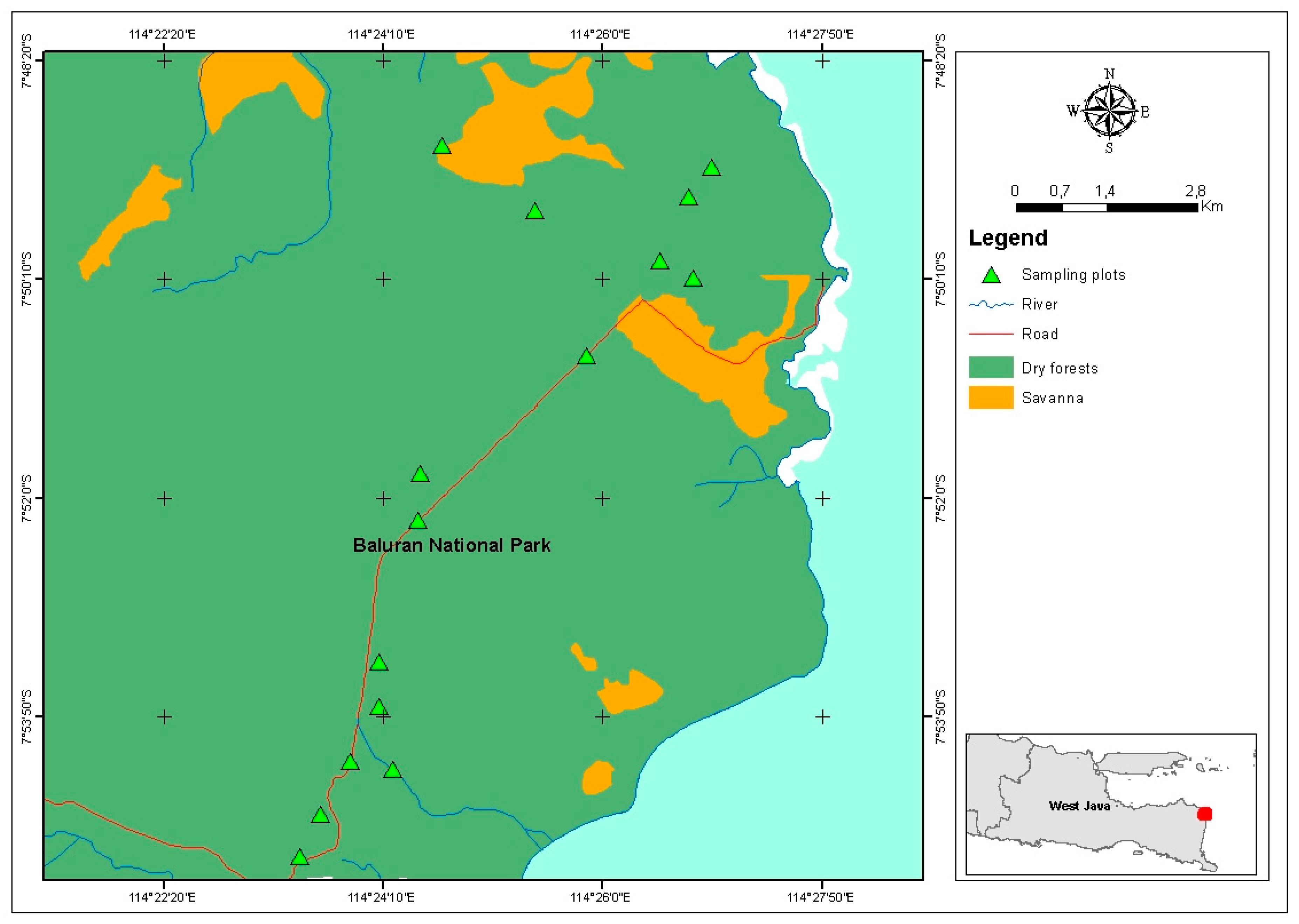
References
- Miles, L.; Newton, A.C.; DeFries, R.S.; Ravilious, C.; May, I.; Blyth, S.; Kapos, V.; Gordon, J.E. A global overview of the conservation status of tropical dry forests. J. Biogeogr. 2006, 33, 491–505. [Google Scholar] [CrossRef]
- Dirzo, R.; Young, H.S.; Mooney, H.A.; Ceballos, G. (Eds.) Seasonally Dry Tropical Forests; Island Press: Washington, DC, USA, 2011. [Google Scholar]
- Sunderland, T.; Apgaua, D.; Baldauf, C.; Blackie, R.; Colfer, C.; Cunningham, A.B.; Dexter, K.; Djoudi, H.; Gautier, D.; Gumbo, D. Global dry forests: A prologue. Int. For. Rev. 2015, 17, 1–9. [Google Scholar] [CrossRef]
- Guzman, B.K.; García-Bravo, A.; Allauja-Salazar, E.E.; Mejía, I.A.; Guzmán, C.T.; Oliva, M. Endemism of woody flora and tetrapod fauna, and conservation status of the inter-Andean Seasonally Dry Tropical Forests of the Marañón valley. Glob. Ecol. Conserv. 2021, 28, e01639. [Google Scholar] [CrossRef]
- Vargas, R.; Allen, M.F.; Allen, E.B. Biomass and carbon accumulation in a fire chronosequence of a seasonally dry tropical forest. Glob. Change Biol. 2008, 14, 109–124. [Google Scholar] [CrossRef]
- Justiniano, M.J.; Fredericksen, T.S. Phenology of tree species in Bolivian dry forests. Biotropica 2000, 32, 276–281. [Google Scholar] [CrossRef]
- Prance, G.T. Tropical savannas and seasonally dry forests: An introduction. J. Biogeogr. 2006, 33, 385–386. [Google Scholar] [CrossRef]
- Oliveras, I.; Malhi, Y. Many shades of green: The dynamic tropical forest—Savannah transition zones. Phil. Trans. R. Soc. B 2016, 371, 20150308. [Google Scholar] [CrossRef] [Green Version]
- Ratnam, J.; Bond, W.J.; Fensham, R.J.; Hoffmann, W.A.; Archibald, S.; Lehmann, C.E.R.; Anderson, M.T.; Higgins, S.I.; Sankaran, M. When is a ‘forest’ a savanna, and why does it matter? Glob. Ecol. Biogeogr. 2011, 20, 653–660. [Google Scholar] [CrossRef]
- Dale, V.H. The Role of Disturbance in Seasonally Dry Tropical Forest Landscapes. In The Ecology and Conservation of Seasonally Dry Forests in Asia; McShea, W.J., Davies, S.J., Bhumpakphan, N., Eds.; Smithsonian Institution Scholarly Press: Washington, DC, USA, 2011; pp. 75–96. [Google Scholar]
- Banda, R.K.; Delgado-Salinas, A.; Dexter, K.G.; Linares-Palomino, R.; Oliveira-Filho, A.; Prado, D.; Pullan, M.; Quintana, C.; Riina, R.; Rodríguez, M.G.M.; et al. Plant diversity patterns in neotropical dry forests and their conservation implications. Science 2016, 353, 1383–1387. [Google Scholar]
- Vieira, D.L.; Scariot, A. Principles of natural regeneration of tropical dry forests for restoration. Restor. Ecol. 2006, 14, 11–20. [Google Scholar] [CrossRef] [Green Version]
- Hartung, M.; Carreño-Rocabado, G.; Peña-Claros, M.; van der Sande, M.T. Tropical Dry Forest Resilience to Fire Depends on Fire Frequency and Climate. Front. For. Glob. Change 2021, 4, 755104. [Google Scholar] [CrossRef]
- Otterstrom, S.M.; Schwartz, M.W.; Velázquez-Rocha, I. Responses to fire in selected tropical dry forest trees. Biotropica 2006, 38, 592–598. [Google Scholar] [CrossRef]
- Clarke, P.J.; Lawes, M.J.; Midgley, J.J.; Lamont, B.B.; Ojeda, F.; Burrows, G.E.; Enright, N.J.; Knox, K.J.E. Resprouting as a key functional trait: How buds, protection and resources drive persistence after fire. New Phytol. 2013, 197, 19–35. [Google Scholar] [CrossRef] [PubMed] [Green Version]
- Bond, W.J.; van Wilgen, B.W. Fire and Plants; Chapman & Hall: London, UK, 1996. [Google Scholar]
- Singh, M.; Sood, S.; Collins, C.M. Fire Dynamics of the Bolivian Amazon. Land 2022, 11, 1436. [Google Scholar] [CrossRef]
- Monk, K.A.; De Fretes, Y.; Reksodihardjo-Lilley, G. Ekologi Nusa Tenggara dan Maluku [Ecology of Nusa Tenggara and Maluku]; Prenhallindo: Jakarta, Indonesia, 2000; p. 984. [Google Scholar]
- Fisher, R.; Bobanuba, W.E.; Rawambaku, A.; Hill, G.J.; Russell-Smith, J. Remote sensing of fire regimes in semi-arid Nusa Tenggara Timur, eastern Indonesia: Current patterns, future prospects. Int. J. Wildland Fire 2006, 15, 307–317. [Google Scholar] [CrossRef]
- Russell-Smith, J.; Djoroemana, S.; Maan, J.; Pandanga, P. Rural Livelihoods and Burning Practices in Savanna Landscapes of Nusa Tenggara Timur, Eastern Indonesia. Human Ecol. 2007, 35, 345–359. [Google Scholar] [CrossRef]
- Tacconi, L.; Moore, P.F.; Kaimowitz, D. Fires in tropical forests: What is really the problem? Lessons from Indonesia. Mitig. Adapt. Strateg. Glob. Change 2007, 12, 55–66. [Google Scholar] [CrossRef]
- Suhadi. Population dynamics of banteng, buffalo and deer in Bekol Savannah, Baluran National Park. Biodiversitas 2009, 10, 139–145. [Google Scholar]
- Pudyatmoko, S.; Budiman, A.; Kristiansen, S. Towards sustainable coexistence: People and wild mammals in Baluran National Park, Indonesia. For. Policy Econ. 2018, 90, 151–159. [Google Scholar] [CrossRef]
- Van Etten, E. Savanna plant communities in the wetter parts of the Indonesian archipelago. Folia Geobot. 2021, 56, 193–204. [Google Scholar]
- Caesariantika, E.; Kondo, T.; Nakagoshi, N. Impact of Acacia nilotica (L.) Willd. ex Del invasion on plant species diversity in the Bekol Savanna, Baluran National Park, East Java, Indonesia. Tropics 2011, 20, 45–54. [Google Scholar] [CrossRef] [Green Version]
- Ratnam, J.; Tomlinson, K.; Rasquinha, D.; Sankaran, M. Savannas of Asia: Antiquity, biogeography, and an uncertain future. Phil. Trans. R. Soc. 2016, 371, 20150305. [Google Scholar] [CrossRef] [PubMed] [Green Version]
- Cole, M.M. Cerrado, Caatinga and Pantanal: The Distribution and Origin of the Savanna Vegetation of Brazil. Geogr. J. 1960, 126, 168–179. [Google Scholar] [CrossRef]
- Archibald, S.; Bond, W.; Stock, W.; Fairbanks, D. Shaping the landscape: Fire-grazer interactions in an African savanna. Ecol. Appl. 2005, 15, 96–109. [Google Scholar] [CrossRef]
- Banfai, D.S.; Bowman, D.M. Dynamics of a savanna-forest mosaic in the Australian monsoon tropics inferred from stand structures and historical aerial photography. Aust. J. Bot. 2005, 53, 185–194. [Google Scholar] [CrossRef]
- Beckage, B.; Bucini, G.; Gross, L.J.; Platt, W.J.; Higgins, S.I.; Fowler, N.L.; Slocum, M.G.; Farrior, C. Water limitation, fire, and savanna persistence: A conceptual model. In Savanna Woody Plants and Large Herbivores; Scogings, P.F., Sankaran, M., Eds.; John Wiley & Sons: Chichester, UK, 2020; pp. 643–659. [Google Scholar]
- Ford, P.L. Grasslands and Savannas. In Encyclopedia of Life Support Systems; Squires, V.R., Ed.; EOLSS Publisher: Singapore, 2010; p. 10. [Google Scholar]
- Van Steenis, C.G.G.J. The Mountain Flora of Java; E.J Brill: Leiden, The Netherlands, 1972. [Google Scholar]
- Hoffmann, W.A.; Geiger, E.L.; Gotsch, S.G.; Rossatto, D.R.; Silva, L.C.R.; Lau, O.L.; Haridasan, M.; Franco, A.C. Ecological thresholds at the savanna-forest boundary: How plant traits, resources and fire govern the distribution of tropical biomes. Ecol. Lett. 2012, 15, 759–768. [Google Scholar] [CrossRef] [PubMed]
- Gardner, T.A. Tree-grass coexistence in the Brazilian cerrado: Demographic consequences of environmental instability. J. Biogeogr. 2006, 33, 448–463. [Google Scholar] [CrossRef]
- Perez-Garcia, E.A.; Meave, J.A. Coexistence and divergence of tropical dry forests and savannas in southern Mexico. J. Biogeogr. 2006, 33, 438–447. [Google Scholar] [CrossRef]
- De Dantas, V.L.; Batalha, M.A.; Pausas, J.G. Fire drives functional thresholds on the savanna-forest transition. Ecology 2013, 94, 2454–2463. [Google Scholar] [CrossRef]
- Sutomo, S.; van Etten, E.; Wahab, L. Proof of Acacia nilotica stand expansion in Bekol Savanna, Baluran National Park, East Java, Indonesia through remote sensing and field observations. Biodiversitas 2016, 17, 96–101. [Google Scholar] [CrossRef]
- Backer, C.A.; van den Brink, R.C.B. Flora of Java; The Rijksherbarium: Leiden, The Netherlands, 1963. [Google Scholar]
- Heim, E. Flora and Vegetation of Bali Indonesia: An Illustrated Field Guide; (BoD)—Books on Demand: Norderstedt, Germany, 2015; ISBN 3-7347-6346-0. [Google Scholar]
- Kent, M. Vegetation Description and Data Analysis: A Practical Approach; John Wiley & Sons: New York, NY, USA, 2011. [Google Scholar]
- Clarke, K.R.; Gorley, R.N. PRIMER: Plymouth Routines in Multivariate Ecological Research; PRIMER-E Ltd.: Plymouth, UK, 2005. [Google Scholar]
- Sutomo. Ecology of Savanna Ecosystems in Indonesia. Ph.D. Thesis, Edith Cowan University, Perth, WA, Australia, October 2017. [Google Scholar]
- Whitten, T.; Soeriaatmadja, R.E.; Afiff, S.A. The Ecology of Java and Bali; Volume II of the Ecology of Indonesia Series; Periplus: Hongkong, China, 1996. [Google Scholar]
- Sutomo, S.; van Etten, E.; Iryadi, R. Use of Landsat imagery to map spread of the invasive alien species Acacia nilotica in Baluran National Park, Indonesia. Biotropia 2019, 27, 88–96. [Google Scholar]
- Smith, T.P. Goodman. Successional dynamics in an Acacia nilotica-Eucleadivinorum savannah in southern Africa. J. Ecol. 1987, 75, 603–610. [Google Scholar] [CrossRef]
- Radford, I.J.; Nicholas, M.D.; Brown, J.R. Impact of prescribed burning on Acacia nilotica seed banks and seedlings in the Astrebla grasslands of northern Australia. J. Arid. Environ. 2001, 49, 795–807. [Google Scholar] [CrossRef]
- Tjitrosoedirdjo, S.; Tjitrosoedirdjo, S.S.; Mawardi, I.; Bachri, S. Invasion of Acacia nilotica into savannas inside Baluran National Park, East Java, Indonesia. In The Role of Weed Science in Supporting Food Security by 2020, Proceedings of the 24th Asian-Pacific Weed Science Society Conference, Bandung, Indonesia, 22–25 October 2013; Bakar, B., Kurniadi, D., Tjitrosoediro, S., Eds.; BIOTROP: Bandung, Indonesia, 2013; pp. 144–150. [Google Scholar]
- Kriticos, D.J.; Sutherst, R.W.; Brown, J.R.; Adkins, S.W.; Maywald, G.F. Climate change and the potential distribution of an invasive alien plant: Acacia nilotica ssp. indica in Australia. J. Appl. Ecol. 2003, 40, 111–124. [Google Scholar] [CrossRef]
- Gonzalez-Rivas, B.; Tigabu, M.; Gerhardt, K.; Castro-Marin, G.; Oden, P.C. Species composition, diversity and local uses of tropical dry deciduous and gallery forests in Nicaragua. In Forest Diversity and Management; Springer: Berlin/Heidelberg, Germany, 2006; pp. 449–467. [Google Scholar]
- Pennington, R.T.; Lavin, M.; Oliveira-Filho, A. Woody plant diversity, evolution, and ecology in the tropics: Perspectives from seasonally dry tropical forests. Annu. Rev. Ecol. Evol. Syst. 2009, 40, 437–457. [Google Scholar] [CrossRef] [Green Version]
- Ashton, P.; Lee, D. (Eds.) Trees & Forests of Tropical Asia: Exploring Tapovan; University of Chicago Press: Chicago, IL, USA, 2022. [Google Scholar]
- Boivin, N.; Crassard, R.; Petraglia, M. (Eds.) Human Dispersal and Species Movement: From Prehistory to the Present; Cambridge University Press: Cambridge, UK, 2017. [Google Scholar]
- Champion, H.G. A Preliminary Survey of Forest Types of India and Burma. Indian For. Rec. (N.S.) Silvic. 1936, 1, 286. [Google Scholar]
- Champion, H.G.; Seth, S.K. A Revised Survey of the Forest Type of India; Manager of Publications: Delhi, India, 1968. [Google Scholar]
- Verma, S.; Singh, D.; Mani, S.; Jayakumar, S. Effect of forest fire on tree diversity and regeneration potential in a tropical dry deciduous forest of Mudumalai Tiger Reserve, Western Ghats, India. Ecol. Process. 2017, 6, 32. [Google Scholar] [CrossRef] [Green Version]
- Kaewsong, K.; Chang-Yang, C.H.; Bunyavejchewin, S.; Kraichak, E.; Yang, J.; Sun, Z.; Zhang, C.; Li, W.; Lin, L.; Sun, I.F. Effects of fire disturbance on species and functional compositions vary with tree sizes in a tropical dry forest. PeerJ 2022, 10, e13270. [Google Scholar] [CrossRef]
- Poorter, L.; Kitajima, K.; Mercado, P.; Chubina, J.; Melgar, I.; Prins, H.H. Resprouting as a persistence strategy of tropical forest trees: Relations with carbohydrate storage and shade tolerance. Ecology 2010, 91, 2613–2627. [Google Scholar] [CrossRef]
- Mostacedo, B.; Viruez, A.; Varon, Y.; Paz-Roca, A.; Parada, V.; Veliz, V. Tree survival and resprouting after wildfire in tropical dry and subhumid ecosystems of Chiquitania, Bolivia. Trees For. People 2022, 10, 100327. [Google Scholar] [CrossRef]
- Lamont, B.B.; He, T.; Yan, Z. Evolutionary history of fire-stimulated resprouting, flowering, seed release and germination. Biol. Rev. 2019, 94, 903–928. [Google Scholar] [CrossRef] [PubMed]
- Hobbs, R.J.; Mooney, H.A. Vegetative regrowth following cutting in the shrub Baccharispilularis ssp. consanguinea (D.C.) C.B. Wolf. Am. J. Bot. 1985, 72, 514–519. [Google Scholar] [CrossRef]
- Williams, R.J.; Gill, A.M.; Moore, P.H.R. Seasonal changes in fire behaviour in a tropical savanna in northern Australia. Int. J. Wildland Fire 1998, 8, 227–239. [Google Scholar] [CrossRef]
- Gillson, L.; Ekblom, A. Resilience and thresholds in savannas: Nitrogen and fire as drivers and responders of vegetation transition. Ecosystems 2009, 12, 1189–1203. [Google Scholar] [CrossRef]
- Twidwell, D.; Fuhlendorf, S.D.; Taylor, C.A.; Rogers, W.E. Refining thresholds in coupled fire–vegetation models to improve management of encroaching woody plants in grasslands. J. Appl. Ecol. 2013, 50, 603–613. [Google Scholar] [CrossRef]
- Hirota, M.; Holmgren, M.; Van Nes, E.H.; Scheffer, M. Global resilience of tropical forest and savanna to critical transitions. Science 2011, 334, 232–235. [Google Scholar] [CrossRef] [PubMed] [Green Version]
- Silva, L.C.; Hoffmann, W.A.; Rossatto, D.R.; Haridasan, M.; Franco, A.C.; Horwath, W.R. Can savannas become forests? A coupled analysis of nutrient stocks and fire thresholds in central Brazil. Plant Soil 2013, 373, 829–842. [Google Scholar] [CrossRef]
- Murphy, P.G.; Lugo, A.E. Ecology of tropical dry forest. Annu. Rev. Ecol. Syst. 1986, 17, 67–88. [Google Scholar] [CrossRef]
- Stuart, N.; Barratt, T.; Place, C. Classifying the Neotropical savannas of Belize using remote sensing and ground survey. J. Biogeogr. 2006, 33, 476–490. [Google Scholar] [CrossRef]
- Tng, D.Y.P.; Apgaua, D.M.G.; Laurance, S.G.W.; Bowman, D.M.J.S. Australia’s Seasonally Dry Tropical Forests Need Attention: Research on This Underappreciated Australian Biome Lags behind Rainforest and Savanna. In Hot Topics in Ecology; Standish, R., Ed.; Published Online; Ecological Society of Australia: Windsor, QLS, Australia, 2017; Available online: http://www.ecolsoc.org.au/hot-topics/australias-seasonally-dry-tropical-forests-need-attention (accessed on 30 September 2022).

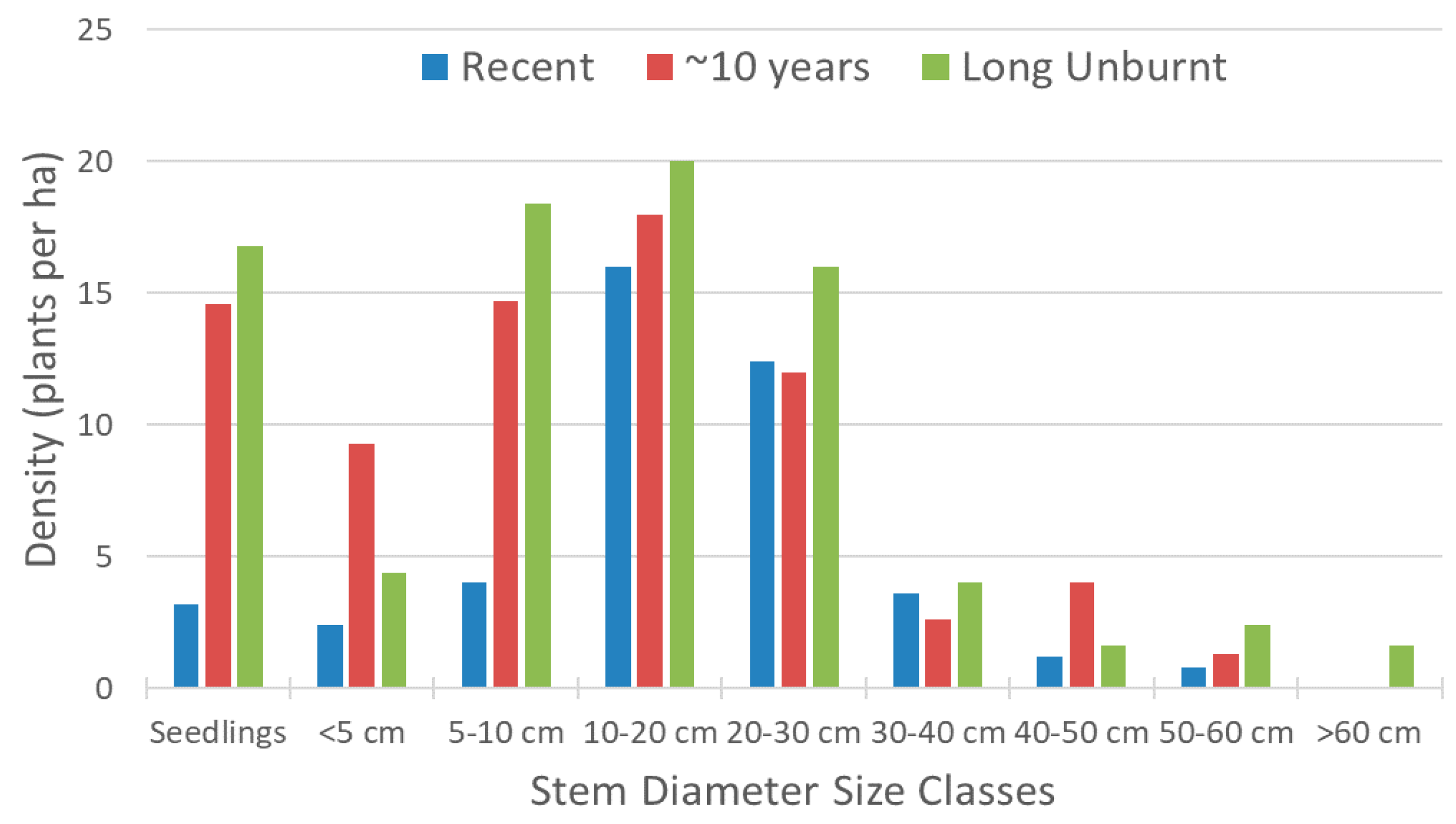


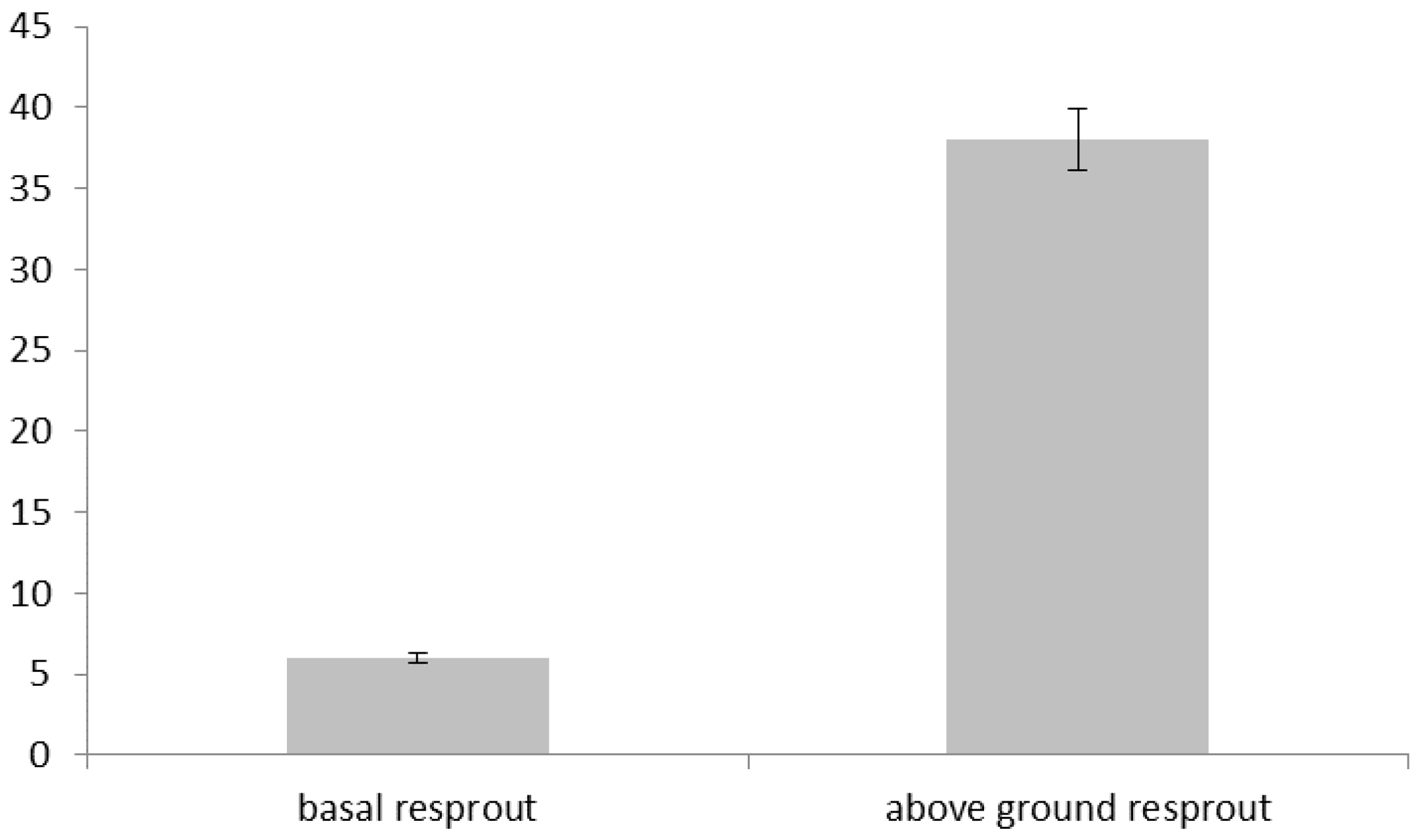

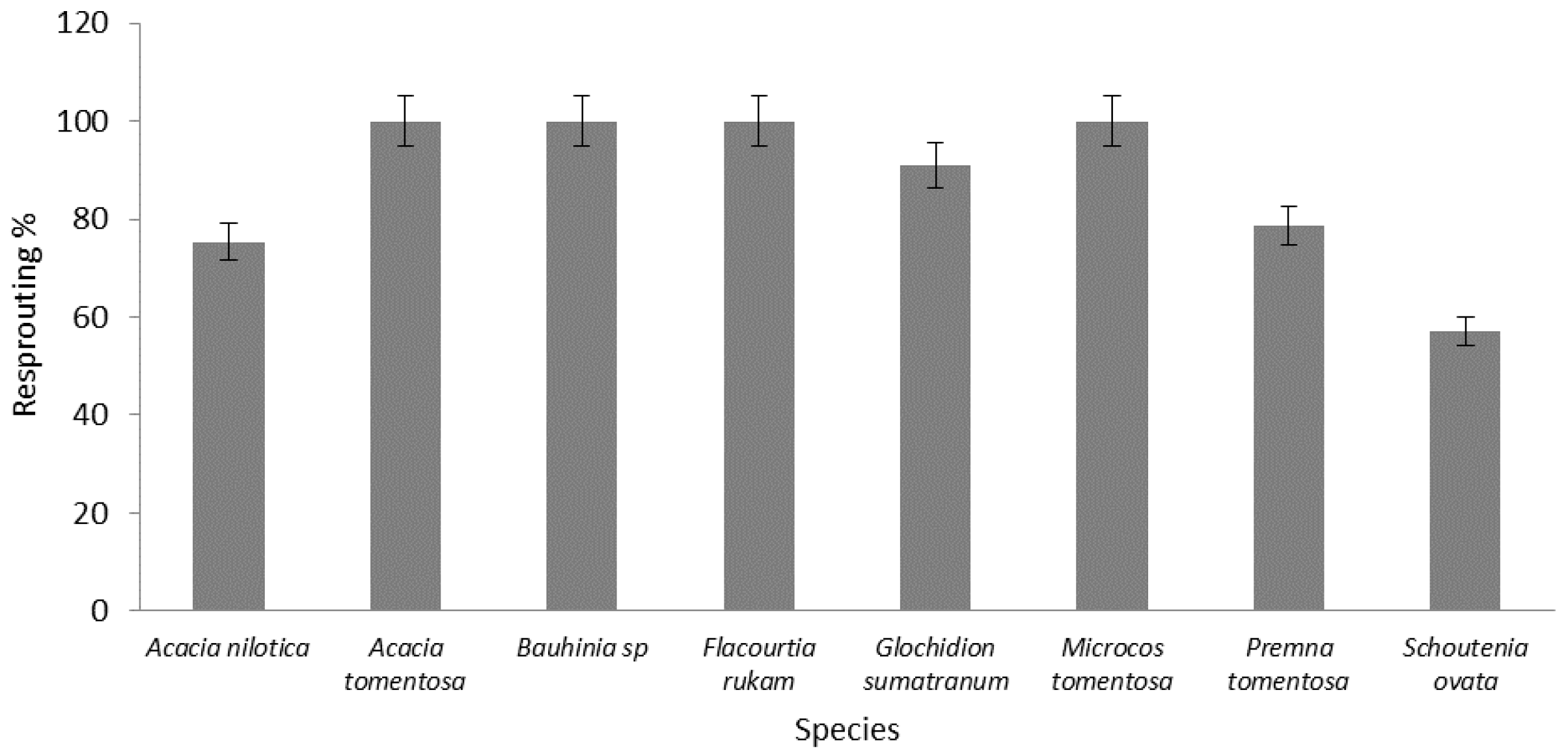
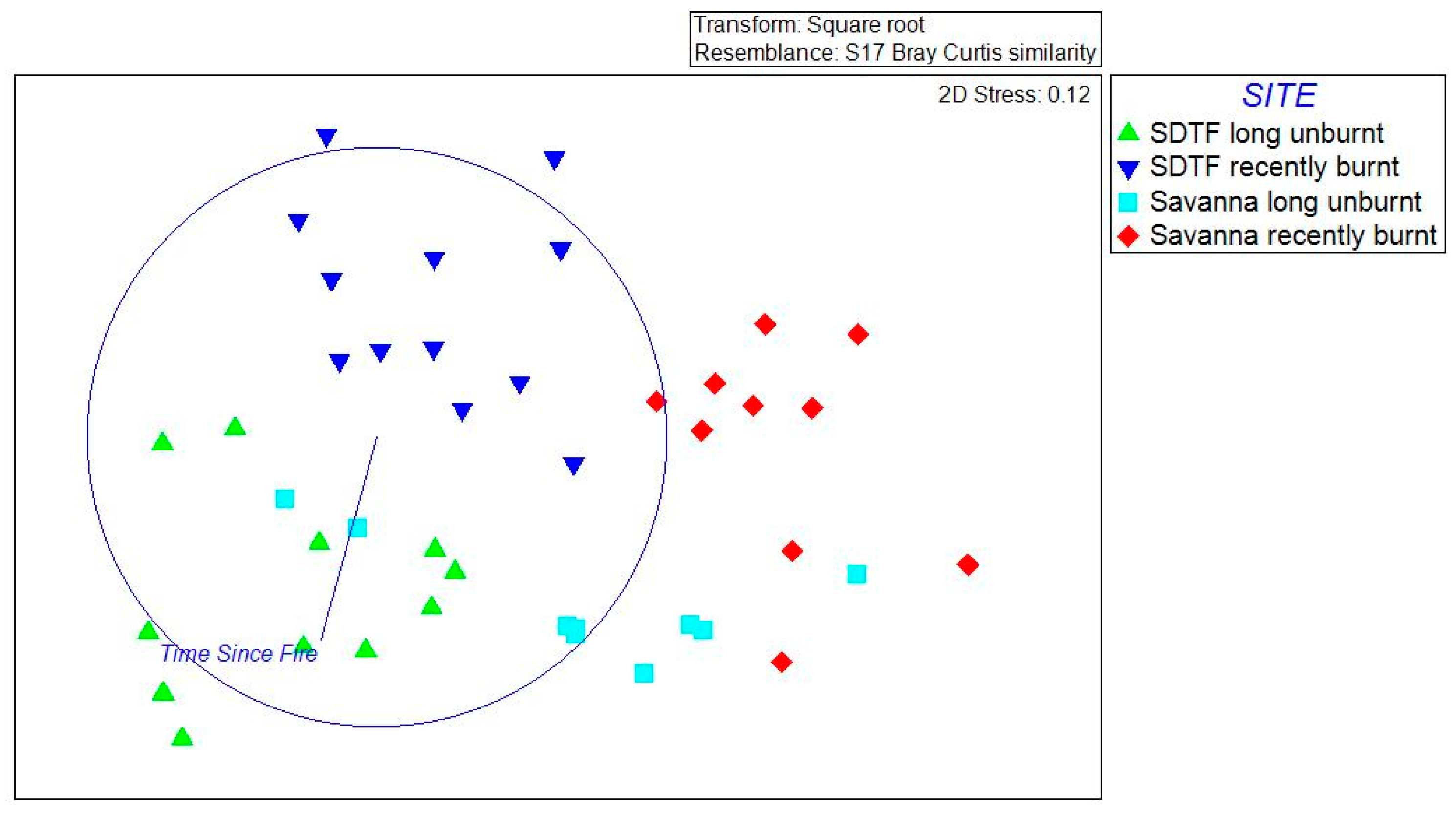
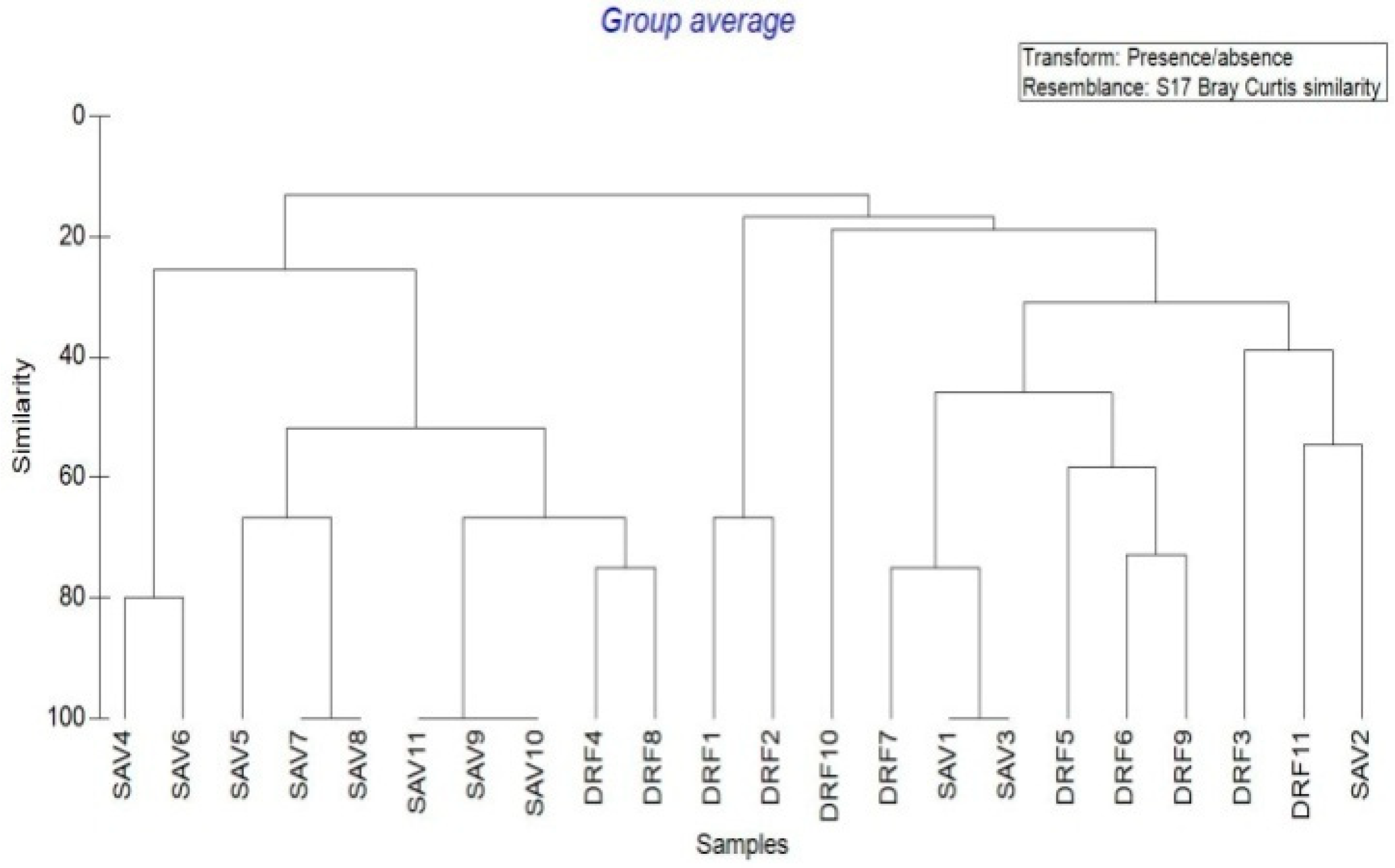
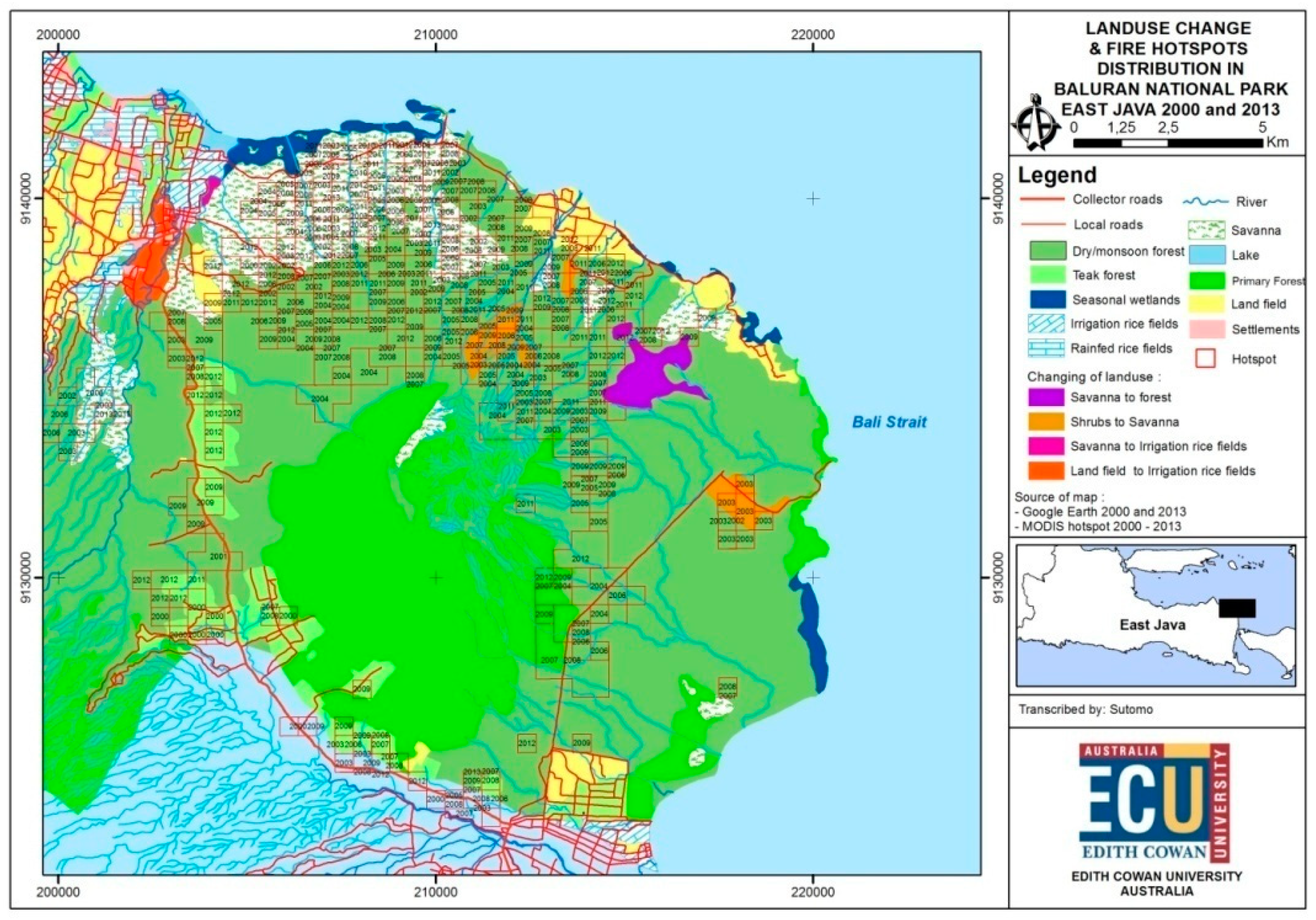
| Species/Stratum | Family | Habit | Importance Value Index |
|---|---|---|---|
| Mature tree (dbh ≥ 20 cm) | |||
| Glochidion zeylanicum | Phyllanthaceae | Tree | 75.14 |
| Premna tomentosa | Lamiaceae | Tree | 51.35 |
| Schoutenia ovata | Tiliaceae | Tree | 28.76 |
| Tamarindus indica | Fabaceae | Tree | 25.34 |
| Schleichera oleosa | Sapindaceae | Tree | 25.25 |
| Flacourtia rukam | Salicaceae | Tree | 15.73 |
| Streblus asper | Moraceae | Tree | 14.65 |
| Poles (dbh 10–20 cm) | |||
| Streblus asper | Moraceae | Tree | 72.96 |
| Capparis sepiaria | Capparaceae | Tree/Shrub | 57.30 |
| Schoutenia ovata | Tiliaceae | Tree | 44.89 |
| Glochidion zeylanicum | Phyllanthaceae | Tree | 43.92 |
| Antidesma bunius | Phyllanthaceae | Tree | 34.21 |
| Premna tomentosa | Lamiaceae | Tree | 13.43 |
| Kleinhovia hospital | Malvaceae | Tree | 12.21 |
| Acronychia trifoliata | Rutaceae | Tree | 11.65 |
| Saplings (height > 1.5 m and dbh < 10 cm) | |||
| Glochidion zeylanicum | Phyllanthaceae | Tree | 55.39 |
| Capparis sepiaria | Capparaceae | Tree/Shrub | 48.94 |
| Schoutenia ovata | Tiliaceae | Tree | 42.14 |
| Streblus asper | Moraceae | Tree | 28.41 |
| Acacia nilotica | Fabaceae | Small Tree | 25.38 |
| Antidesma bunius | Phyllanthaceae | Tree | 23.04 |
| Kleinhovia hospita | Malvaceae | Tree | 20.05 |
| Abutilon indicum | Malvaceae | Small shrub | 15.72 |
| Hibiscus panduriformis | Malvaceae | Shrub | 13.46 |
| Tamarindus indica | Fabaceae | Tree | 12.94 |
| Ground cover | |||
| Brachiaria ramosa | Poaceae | Perennial Grass | 22.80 |
| Chionachne punctata | Poaceae | Perennial Grass | 22.25 |
| Mimosa invisa * | Mimosaceae | Herb | 18.64 |
| Oplismenus burmannii | Poaceae | Annual Grass | 12.80 |
| Cosmos caudatus * | Asteraceae | Annual Herb | 10.32 |
| Diss/SD | Contrib% | |||||
|---|---|---|---|---|---|---|
| Species | 10 Years vs. Recent | 10 Years vs. Unburned | Recent vs. Unburned | 10 Years vs. Recent | 10 Years vs. Unburned | Recent vs. Unburned |
| Groundcover | ||||||
| Brachiaria ramosa | 1.27 | - | - | 10.03 | - | - |
| Cosmos caudatus | - | 1.7 | 1.8 | - | 16.36 | 12.83 |
| Oplismenus burmannii | 1.43 | 1.35 | 11.2 | 11.97 | - | |
| Chionachne punctata | 1.44 | - | 1.52 | 12.63 | - | 10.41 |
| Mimosa invisa | 0.88 | 0.58 | 0.98 | 8.32 | 3.51 | 8.03 |
| Trees | ||||||
| Flacourtia rukam | - | 1.85 | 1.81 | - | 13.45 | 14.58 |
| Glochidion zeylanicum | 1.44 | 1.30 | 1.25 | 21.03 | 9.31 | 10.03 |
| Premna tomentosa | 1.4 | 1.07 | 1.45 | 21.28 | 7.5 | 44.11 |
| Schleichera oleosa | - | 0.92 | 0.93 | - | 13.94 | 15.04 |
| Schoutenia ovata | 0.82 | 0.89 | 1.04 | 11.35 | 9.17 | 9.67 |
| Streblus asper | - | 0.69 | - | - | 9.37 | - |
| SDTF | Unburned Savanna | |||
|---|---|---|---|---|
| Species | Av. Abund | Av. Abund | Contrib% | Cum.% |
| Erythrina euodiphylla | 1.87 | 0.47 | 21.15 | 21.15 |
| Flacourtia rukam | 0.33 | 1.28 | 11.25 | 32.4 |
| Hibiscuspanduriformis | 0.82 | 0 | 8.71 | 41.11 |
| Schoutenia ovata | 2.55 | 2.46 | 8.54 | 49.65 |
| Schleichera oleosa | 0.47 | 0.67 | 8.26 | 57.91 |
| Grewia eriocarpa | 0.67 | 0 | 7.79 | 65.7 |
| Acacia leucophloea | 0 | 0.67 | 6.51 | 72.2 |
| Capparis sepiaria | 0.33 | 0.33 | 5.15 | 77.35 |
| Tamarindus indica | 0.33 | 0.33 | 4.92 | 82.27 |
| Glochidionzeylanicum | 0.33 | 0 | 3.81 | 86.08 |
| Cordia bantamensis | 0.33 | 0 | 3.56 | 89.63 |
| Helicteres isora | 0.33 | 0 | 3.56 | 93.19 |
| Vegetation | Soil | pH | C% | N% |
|---|---|---|---|---|
| Savanna | Volcanic | 6.74 Neutral | 3.51 High | 0.23 Medium |
| SDTF | Volcanic | 6.65 Neutral | 4.39 High | 0.27 Medium |
Disclaimer/Publisher’s Note: The statements, opinions and data contained in all publications are solely those of the individual author(s) and contributor(s) and not of MDPI and/or the editor(s). MDPI and/or the editor(s) disclaim responsibility for any injury to people or property resulting from any ideas, methods, instructions or products referred to in the content. |
© 2023 by the authors. Licensee MDPI, Basel, Switzerland. This article is an open access article distributed under the terms and conditions of the Creative Commons Attribution (CC BY) license (https://creativecommons.org/licenses/by/4.0/).
Share and Cite
Sutomo; van Etten, E.J.B. Fire Impacts and Dynamics of Seasonally Dry Tropical Forest of East Java, Indonesia. Forests 2023, 14, 106. https://doi.org/10.3390/f14010106
Sutomo, van Etten EJB. Fire Impacts and Dynamics of Seasonally Dry Tropical Forest of East Java, Indonesia. Forests. 2023; 14(1):106. https://doi.org/10.3390/f14010106
Chicago/Turabian StyleSutomo, and Eddie J. B. van Etten. 2023. "Fire Impacts and Dynamics of Seasonally Dry Tropical Forest of East Java, Indonesia" Forests 14, no. 1: 106. https://doi.org/10.3390/f14010106
APA StyleSutomo, & van Etten, E. J. B. (2023). Fire Impacts and Dynamics of Seasonally Dry Tropical Forest of East Java, Indonesia. Forests, 14(1), 106. https://doi.org/10.3390/f14010106







